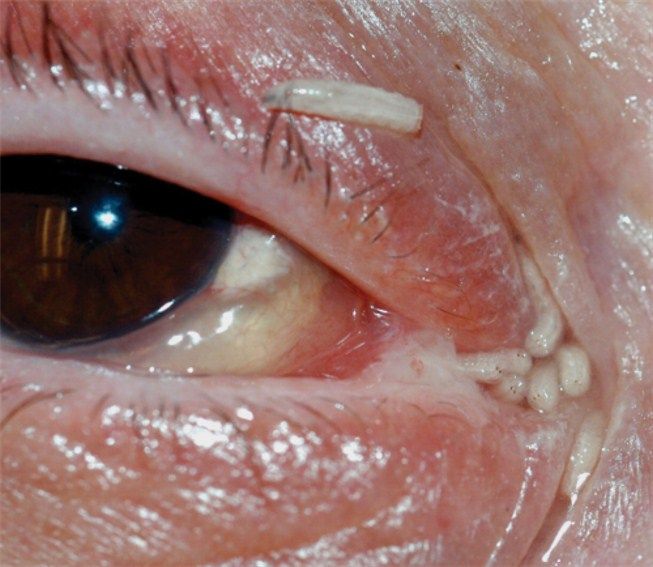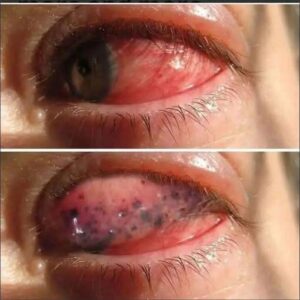Treatment of Nosocomial Myiasis
Treatment of Nosocomial Myiasis

Nosocomial myiasis, an infestation of fly larvae (maggots) acquired in a healthcare setting, is a rare but serious complication. It typically occurs in patients with compromised immune systems, poor hygiene, prolonged hospital stays, or open wounds. This condition not only poses a significant health risk to the patient but also reflects lapses in hospital infection control practices.
Case Overview: Nosocomial myiasis can affect any body part, though it is more commonly found in wounds, body cavities, or areas with necrotic tissue. Early identification and prompt treatment are essential to prevent severe tissue damage, secondary infections, and systemic complications.

Treatment Process:
- Mechanical Removal: The first line of treatment is the immediate mechanical removal of larvae. This is typically performed under sterile conditions, often using forceps, to extract all visible larvae from the wound or affected area. Local anesthesia may be administered to ensure patient comfort.
- Wound Irrigation and Disinfection: After removal, the affected site is thoroughly cleaned and irrigated with antiseptic solutions, such as hydrogen peroxide, iodine, or saline, to flush out any remaining larvae and sterilize the wound. This reduces the risk of bacterial infection, which is common in myiasis-affected tissue.
- Pharmacological Treatment: Systemic antiparasitic agents like ivermectin may be prescribed to eliminate any larvae that remain undetected. Additionally, antibiotics are often administered to treat or prevent secondary bacterial infections.
- Wound Management: Proper wound care is essential post-treatment. Dressings should be changed frequently, and strict hygiene protocols should be enforced to promote healing and prevent reinfestation.
- Prevention of Recurrence: Hospitals must address the root causes of nosocomial myiasis. This includes improving sanitation, monitoring for insect infestations, and ensuring patient hygiene, especially in high-risk wards like intensive care units.
Follow-Up Care: Patients require close monitoring to ensure proper healing and detect any signs of reinfestation or infection. Regular wound assessments and follow-up visits are essential.
4o
Nosocomial myiasis, an infestation of fly larvae (maggots) acquired in a healthcare setting, is a rare but serious complication. It typically occurs in patients with compromised immune systems, poor hygiene, prolonged hospital stays, or open wounds. This condition not only poses a significant health risk to the patient but also reflects lapses in hospital infection control practices.
Case Overview: Nosocomial myiasis can affect any body part, though it is more commonly found in wounds, body cavities, or areas with necrotic tissue. Early identification and prompt treatment are essential to prevent severe tissue damage, secondary infections, and systemic complications.
Treatment Process:
- Mechanical Removal: The first line of treatment is the immediate mechanical removal of larvae. This is typically performed under sterile conditions, often using forceps, to extract all visible larvae from the wound or affected area. Local anesthesia may be administered to ensure patient comfort.
- Wound Irrigation and Disinfection: After removal, the affected site is thoroughly cleaned and irrigated with antiseptic solutions, such as hydrogen peroxide, iodine, or saline, to flush out any remaining larvae and sterilize the wound. This reduces the risk of bacterial infection, which is common in myiasis-affected tissue.
- Pharmacological Treatment: Systemic antiparasitic agents like ivermectin may be prescribed to eliminate any larvae that remain undetected. Additionally, antibiotics are often administered to treat or prevent secondary bacterial infections.
- Wound Management: Proper wound care is essential post-treatment. Dressings should be changed frequently, and strict hygiene protocols should be enforced to promote healing and prevent reinfestation.
- Prevention of Recurrence: Hospitals must address the root causes of nosocomial myiasis. This includes improving sanitation, monitoring for insect infestations, and ensuring patient hygiene, especially in high-risk wards like intensive care units.
Follow-Up Care: Patients require close monitoring to ensure proper healing and detect any signs of reinfestation or infection. Regular wound assessments and follow-up visits are essential.





